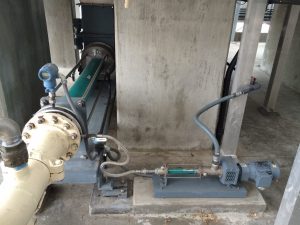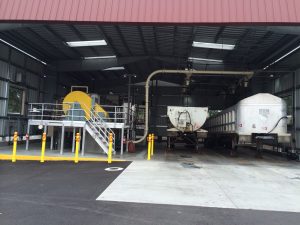By Jeff Helm, Western Regional Manager, NETZSCH Pumps North America, LLC, and Greg Scott; Flo-Line Technology
When California’s Sonoma County Water Agency (SCWA) wanted to improve its sludge solids dewatering as part of a major sludge handling upgrade, they were seeking an alternative to outdated sludge belt press/conveyor technology. After reviewing options, SCWA opted for screw press technology, selecting sludge cake progressing cavity pumps by NETZSCH specifically designed to convey dewatered sludge easily. Since implementing the system, SCWA has greatly increased its cake sludge solids content, significantly reducing its sludge hauling costs, while also making sludge loading simpler and more convenient. Maintenance costs have also been reduced.
Agency seeks improved sludge cake handling
SCWA provides wastewater collection and treatment and recycled water distribution and disposal services for approximately 30,000 residences and businesses in Sonoma County, California. SCWA operates and manages eight sanitation districts and zones. The SCWA is also responsible for provision of naturally filtered drinking water, as well as, flood protection services.
The sludge dewatering equipment at the SCWA’s Sonoma Valley County Sanitation District (District) wastewater treatment facility included a belt filter press that was old and outdated. According to John Albrecht, SCWA’s Maintenance Supervisor, it was increasingly difficult to obtain parts for the antiquated technology, and costly replacement parts made it expensive to maintain.
In addition, the technology was not providing the performance they were looking for in terms of the cake solids percentage. “We pay tipping scale fees to haul dewatered sludge for disposal in a landfill. The more water we haul, the more we have to pay,” said Albrecht. “Rather than paying to haul water, we want to haul solids. Our ultimate goal was to get a better and more consistent cake solids percentage – in the range of 18 to 22 percent – and our older belt press technology just could not get us there.”
The District decided it wanted to move in a different direction for sludge dewatering. After reviewing available options, including a centrifuge and other biosolids technologies, they settled on a screw press, a simple and proven technology in which a slow moving device accomplishes dewatering by continuous gravitational drainage. Before making the decision, they toured several plants and conducted extensive talks with project engineers and maintenance personnel. All agreed the option offers lower maintenance costs and operating costs and higher reliability, with an extremely consistent end product.
The quest for improved sludge cake handling was part of a larger sludge solids handling upgrade and improvement project being developed by the District and its consulting engineers. The complete project involved the new screw press, a new sludge handling building, and a truck loading and trailer facility.
In the initial phase of their facility upgrade, the District purchased three NEMO® BY progressing cavity pumps to feed the existing dewatering belt filter press. After dewatering the sludge load, a conveyor is used to move the dewatered sludge. It was then loaded into trailers and trucked to a land application site.
After installing the NETZSCH progressing cavity pumps in 2010, the District continued with its plans to transition to a screw press for the sludge dewatering. SCWA’s goal was to use a pump, rather than a conveyor, to transfer the dewatering press sludge from the screw press to the truck loading station.
The District had several issues with the existing conveyor system. The first issue is the difficultly to move the sludge cake to more than one location. Trailers are 30 or 40 feet long and the sludge must be evenly loaded in each trailer. The conveyor moves the sludge to only one point in the trailer, and employees had to then manually distribute the sludge to fill it up evenly. With a pump, sludge could be piped to multiple locations and a system of valves used to fill the trailer evenly.
A second concern is that a conveyor is open and moves the sludge on a belt, resulting in spillage and odor, whereas a pump would be totally enclosed in a pipe, eliminating both issues.
A third factor is maintenance. All conveyor devices have relatively high maintenance costs for routine replacement of belts and screws, as well as bearings and drives. The costs increase when long distances must be covered and when the conveyor has to turn a corner or change direction; for example, each change in direction requires a new motor.
By contrast, with a cake sludge pump, only one drive is required, and the pump does all the work. There are no more belt or conveyor component replacements, fewer bearings, and fewer motors, so maintenance costs tend to be lower. Typically, if the distance is longer than 50 feet, or if there is a need to turn corners or go to multiple points, using the pump is more cost effective.
Progressing cavity pump solution
After considering these issues, the District selected the progressing cavity pump as the preferred option. Working with local pump distributor Flo-Line Technology, the District sought to take advantage of NETZSCH’s sludge cake pumping expertise with progressing cavity pumps. Albrecht notes that they he had originally viewed a range of NETZSCH sludge cake handling pumps at a WEFTEC conference; NETZSCH pump experts later toured the Sonoma Valley plant and suggested that these pumps would indeed be an excellent fit for the new screw press system.
NETZSCH and Flo-Line then worked with the District and its consulting engineers to provide technical and budgetary information for the sludge cake pumping system. They went through several iterations to refine the needs.
The District then conducted a competitive bidding process as part of the general contract for the solids handling project. The specifications were written to provide ideal performance in terms of cake sludge solids percentage, pumping pressure, and a variety of other design criteria.
After considering several bids, the District ultimately selected the NEMO® – BF/SF Sludge Cake Progressing Cavity Pumps, as shown on Figure 1.
The pump’s enlarged housing has a fully customizable rectangular hopper and force feed chamber for easier entry of the product into the rotor and stator. The coupling rod incorporates a patented positioned feed screw that extends over the joints and is always positioned opposite the open cavity of the stator. This pushes the sludge cake directly into the open cavity in the shortest possible route. It improves the chamber filling by up to 50 percent as compared to other pumps with random positioning of the screw.
Also included was an asynchronous bridge prevention (aBP) module to prevent sludge “bridging” in the chute below the screw press, which could then block the inlet to the pump. Bridging occurs when thick and dry dewatered sludge cakes together. If sticky enough, it can build up on the walls of the chute and then actually “bridge” over the top of the auger in the pump, stick to itself, and not drop down with gravity into the pump.
 The aBP module, shown on Figure 2, consists of two flat spoked wheels, one on each long side of the chute. It has its own small (¼-HP) motor, which turns very slowly. The module essentially makes a moving wall in the chute, preventing the material from building up on the walls, because the flat large diameter wheels turn very slowly at slightly different speeds from one another. Installation of the aPB allowed the sludge cake pump to handle even the stickiest, most bridge-prone sludge.
The aBP module, shown on Figure 2, consists of two flat spoked wheels, one on each long side of the chute. It has its own small (¼-HP) motor, which turns very slowly. The module essentially makes a moving wall in the chute, preventing the material from building up on the walls, because the flat large diameter wheels turn very slowly at slightly different speeds from one another. Installation of the aPB allowed the sludge cake pump to handle even the stickiest, most bridge-prone sludge.
The project was initially planned for construction in 2012 but was delayed for budgetary reasons. The equipment was delivered and the installation was completed, with facility startup in the January of 2014. NETZSCH provided the pump to the contractor, FKC provided the screw press, and the contractor installed all the equipment, all the piping work, and the building construction. Flo-Line Technology assisted with the development, design, commissioning, and system optimization, offering a turnkey solution to the client.
Working out the kinks
After operations began, the District experienced a significantly high pressure drop, which resulted in some difficulty pumping the muddy dirt-like material through the very long spans to the trailers sitting side by side in the new sludge loading building. There were three spots they could dump sludge in each trailer. The system included six valves – three for each truck. The spot farthest away required a pressure of 360 pounds per square inch (psi). While technically feasible, such a pressure was higher than the pump’s intended design, and might have resulted in very high wear and relatively short life.
The District requested recommendations for fixing the situation. The initial suggestion of replacing the facility’s 6-inch glass-lined pipes (used because it is smooth on the inside to reduce friction) with 8-inch pipes would have been extremely costly. The ultimate solution included changing the elbows used for changing direction from a tight bend to very long radius elbows, thus reducing significant pressure losses in the elbows.
 The District also added NETZSCH’s friction loss reduction (FLR) system, which essentially produces a slippery layer on the walls of the pipe to reduce friction. The FLR system, shown on Figure 3, consists of a small progressing cavity pump that injects a layer of polymer along the outer diameter of the pipe.
The District also added NETZSCH’s friction loss reduction (FLR) system, which essentially produces a slippery layer on the walls of the pipe to reduce friction. The FLR system, shown on Figure 3, consists of a small progressing cavity pump that injects a layer of polymer along the outer diameter of the pipe.
Using a ring nozzle, the FLR system provides a continuous 360° even layer around the entire pipe surface that reduces friction loss within the pipeline and allows for pressure reductions of up to 50 percent. This let the District achieve considerable reductions in pressure, cutting back on operating costs and improving system lifetime. As a result of these changes, the pressure experienced at the valve farthest away from the pump is now 220 psi, a roughly one third drop in pressure loss. The pressure is now in line with the original design considerations. Figure 4 shows the loading bay in operation.
According to the District’s John Albrecht, the pumps have been performing very well for more than a year of operations, with very low maintenance and easy availability of parts. “My job is to make things run and stay running, and the quality of these pumps is high. They are reliable, easy to run, and very accurate. You dial up the percentage and know exactly what it will be, with no variation in the gallon per minute discharge. They also have run-dry protection, with a thermocouple on the stator that shuts it down if it is too hot. We got the kinks worked out well and it is a very robust system that does what it is supposed to do.”






